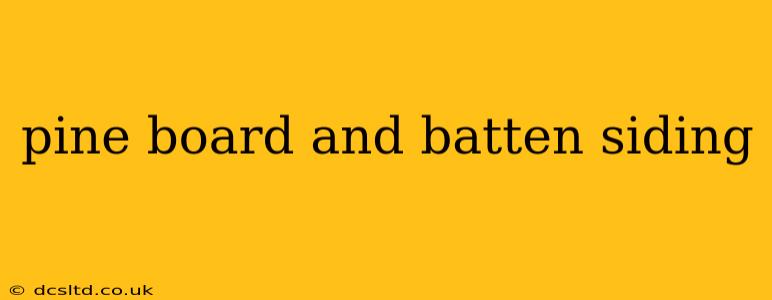Pine board and batten siding offers a timeless appeal, blending rustic charm with modern durability. This classic siding style, characterized by its vertical planks and narrow battens covering the seams, adds undeniable character to any home. But what exactly makes pine board and batten so popular, and what should you consider before choosing it for your own project? This comprehensive guide will explore the advantages, disadvantages, and crucial factors to consider when selecting pine board and batten siding.
What is Board and Batten Siding?
Board and batten siding is a type of vertical siding where wide boards (typically 6-8 inches wide) are installed vertically, with narrower strips of wood—the battens—covering the gaps between the boards. This creates a clean, visually appealing look with a distinct vertical emphasis. The battens not only add aesthetic appeal but also provide additional protection against the elements and enhance the siding's durability. Pine is a popular choice for this siding due to its affordability, workability, and naturally attractive grain.
Why Choose Pine for Board and Batten Siding?
Pine's popularity in board and batten applications stems from several key advantages:
- Affordability: Compared to other wood species like cedar or redwood, pine is generally more budget-friendly, making it an accessible choice for homeowners.
- Workability: Pine is relatively soft and easy to work with, making it a good option for DIY projects or for those comfortable with basic woodworking skills.
- Attractive Grain: Pine boasts a beautiful, natural grain pattern that adds warmth and character to any home's exterior.
- Paintability: Pine readily accepts paint and stain, offering flexibility in customizing the final look to match your home's style.
What are the Disadvantages of Pine Board and Batten Siding?
While pine offers several advantages, it's important to be aware of potential drawbacks:
- Durability: Compared to some hardwoods, pine is less durable and more susceptible to damage from insects, moisture, and weathering. Proper treatment and maintenance are essential.
- Maintenance: Regular maintenance, including painting or staining, is crucial to protect pine siding from the elements and extend its lifespan.
- Knots: Pine often contains knots, which can add to its rustic charm but can also be a source of weakness.
How Much Does Pine Board and Batten Siding Cost?
The cost of pine board and batten siding varies considerably depending on factors such as:
- Grade of lumber: Higher-grade pine with fewer knots will be more expensive.
- Thickness of boards and battens: Thicker lumber is typically more costly.
- Regional pricing: Lumber prices fluctuate depending on location and availability.
- Labor costs: If you hire a contractor for installation, labor costs can significantly impact the overall project expense.
How Long Does Pine Board and Batten Siding Last?
With proper installation and maintenance, pine board and batten siding can last for 15-20 years or even longer. However, neglecting regular maintenance can significantly shorten its lifespan. Regular painting or staining every 3-5 years is recommended to protect the wood from the elements and prevent damage.
Is Pine Board and Batten Siding Easy to Install?
While pine's workability makes it easier to install than some other materials, installing board and batten siding still requires skill and attention to detail. Proper preparation, including ensuring a level and properly sheathed wall, is crucial for a successful installation. If you lack experience with exterior siding projects, hiring a professional contractor is recommended.
What Kind of Maintenance Does Pine Board and Batten Siding Need?
Regular maintenance is key to extending the life of your pine board and batten siding. This includes:
- Annual inspections: Check for any signs of damage, such as cracks, rot, or insect infestation.
- Regular cleaning: Clean the siding periodically to remove dirt, debris, and mildew.
- Repainting or restaining: Every 3-5 years, repaint or restain your siding to protect it from the elements.
Is Pine Board and Batten Siding a Good Investment?
Pine board and batten siding can be a worthwhile investment if you prioritize its aesthetic appeal and are prepared for the necessary maintenance. Its relatively lower cost compared to other options makes it an attractive choice for many homeowners. However, remember that the long-term cost depends heavily on the upkeep.
This guide provides a comprehensive overview of pine board and batten siding. Remember that the best choice for your home will depend on your budget, aesthetic preferences, and the climate in your region. Consult with a qualified contractor for personalized advice and professional installation.
